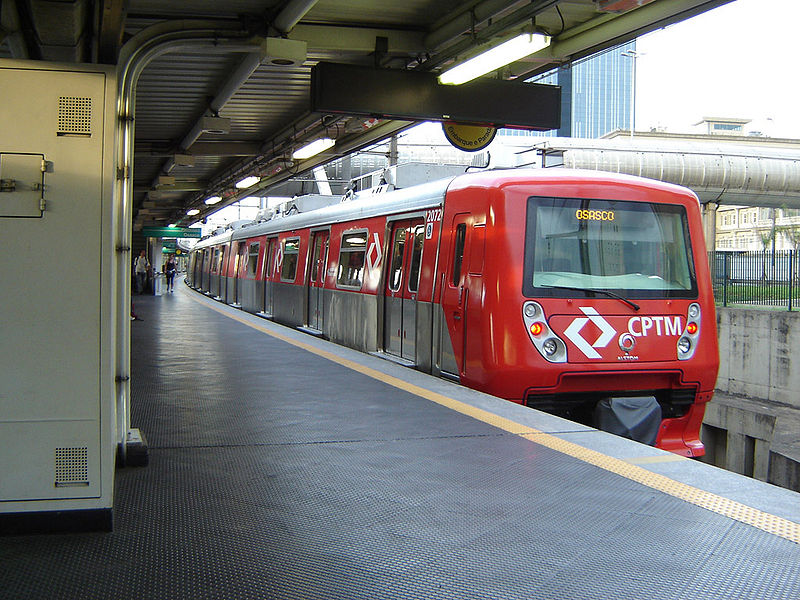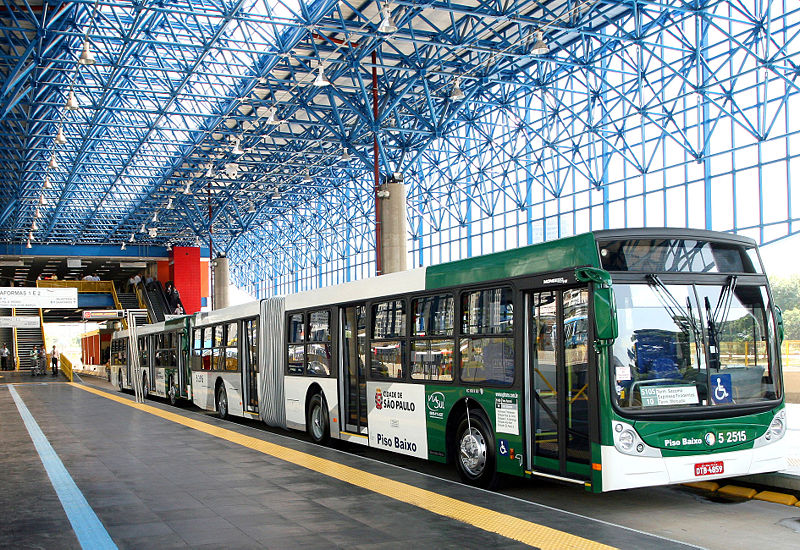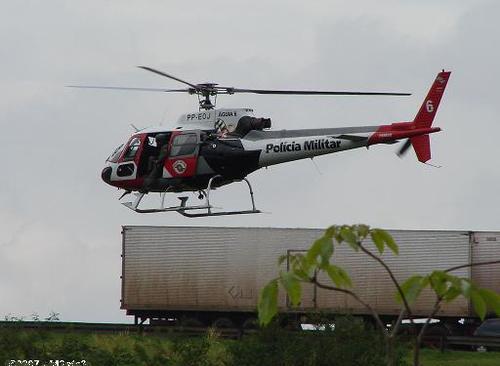Underground and Light-Rail System
The city has 61.3 km (38.1 mi) of underground railway systems (34.6 km (21.4 mi) fully underground) (the SĂŁo Paulo Metro, locally known as the MetrĂ´), with 4 lines in operation and 55 stations, complemented by another 261.7 km (162.6 mi) of Companhia Paulista de Trens Metropolitanos (CPTM, or "Paulista Company of Metropolitan Trains") railways. Both CPTM and the underground railway lines carry some 5 million people on an average weekday, and a few new underground lines to be constructed are expected to add another million people to the system within the next four years. The project is expected to expand SĂŁo Paulo's urban railway system from the current 323 km (201 mi) to more than 500 km (310 mi) on the next 10 years.
SĂŁo Paulo has three rapid transport systems:
- The underground rail system (called "metrĂ´", short for "metropolitano"), with four lines
- The suburban rail system, Companhia Paulista de Trens Metropolitanos (CPTM), has six lines that serve many regions not reached by the underground system, and even some other cities in the metropolitan region. The CPTM network is longer than the underground rail system.
- The fast-lane bus system that uses bus lines called "Passa Rápido", which are street-level, placed on large avenues, and connected with the underground or suburban train stations.
SĂŁo Paulo has no tram lines, although trams used to be common in the first half of the 20th century. SĂŁo Paulo's underground train system is modern, safe, clean and efficient, considered one of the best subway systems in the world, as certified by the NBR ISO 9001. It has four lines (a fifth, the Yellow line, is under construction) and links to the metropolitan train network, the CPTM.

Train of SĂŁo Paulo Metro.
The underground rail lines are:
Line 1 - Blue: The first subway line built connects the North and the South Side of SĂŁo Paulo. Connections are available for the Green, Red and Yellow lines and also for CPTM trains. TietĂŞ and Jabaquara bus terminals are also reachable through the use of this line.
Line 2 - Green: The Green line transverses the Paulista Avenue ridge, connecting Ipiranga to Vila Madalena, and also integrating the Blue and Yellow lines. It was the third MetrĂ´ line built.
Line 3 - Red: One of SĂŁo Paulo's busiest lines, the second MetrĂ´ line built connects the East Side to the West Side. Connections to the Blue and Yellow lines are possible, as are with CPTM trains. The Barra Funda bus terminal is located on this line.
Line 4 - Yellow (under construction): Scheduled to be open in 2009, the Yellow line will connect the central Luz station to the west side in a route constructed immediately below the Consolação and Rebouças avenues. Connections will be available to the Blue, Green and Red lines and to CPTM trains.
Line 5 - Lilac: Built for users who need to reach specific places in SĂŁo Paulo's South Side. Only a short distance of the line is already available (six complete stations), connecting to CPTM trains at Santo Amaro station.
Line 6 - Orange (planned): Announced in 2008 and scheduled to be open in 2012, the Orange Line will connect the borough of Freguesia do Ă“, in the northwestern side of the city to downtown SĂŁo Paulo. It will be connected to the subway lines 1 and 4, as well as the line 7 of CPTM.

Train of CPTM.
The following lines are composed by surface trains and managed by CPTM, named after precious stones:
Line 7 - Ruby: Formerly the northern part of the ancient SĂŁo Paulo Railway, it connects the Luz station downtown to the city of Francisco Morato, crossing all of the northwestern side of the city. An operational extension connects Francisco Morato to the city of JundiaĂ. This is the longest line of the railway system in SĂŁo Paulo.
Line 8 - Diamond: Formerly part of the ancient Estrada de Ferro Sorocabana, it connects the Julio Prestes station downtown to Itapevi, going across the western side of the city. An operational extension with another train links this line to four more stations in Itapevi. The last station (Amador Bueno) is placed near the border with SĂŁo Roque. The Julio Prestes station houses the State of the Art concert hall Sala Cidade de SĂŁo Paulo.
Line 9 - Emerald: It's located along the Nações Unidas Avenue (Marginal Pinheiros), and connects the region of the Interlagos Speedway to the neighbouring city of Osasco. Presently, it makes the only connection with the subway Line 5 - Lilac.
Line 10 - Turquoise: Formerly the southern part of the ancient SĂŁo Paulo Railway, it's actually a continuation of the Line 7 - Ruby, and crosses the ABC Region.
Line 11 - Coral: Also known as "Expresso Leste" (East Express), it crosses all the eastern side of São Paulo from downtown, to Guaianases. It is within the largest distance between two stations (between Tatuapé and Itaquera) in all the railway net. There is an operational extension from Guaianases to the campus of the Universidade de Mogi das Cruzes (University of Mogi das Cruzes), in the city of Mogi das Cruzes.
Line 12 - Sapphire: It crosses the northeastern side of São Paulo, from the Brás station downtown until the city of Itaquaquecetuba.
Buses

Bus Terminal TietĂŞ, the second largest Bus Terminal in the world.

Articulated buses on Tiradentes Express.

Modern Trolleybus in SĂŁo Paulo.
The bulk of the public transport (government and private companies) is composed of approximately 17,000 buses (including about 210 trolley buses), coloured uniformly according to the non-central region served (ex.: light green for the buses that go South West, dark blue for the Northern area).
Until the past few years, there was a strong presence of informal transport vans (dab vans), but the vast majority of such vans are already fully registered with the city council, legalized and operating under the same color scheme of the main system.
In a transportation world that has dreamed up such systems as maglev bullet trains and "smart roads" capable of guiding vehicles, bus-based mass transit may appear quite low-tech. But in SĂŁo Paulo the buses themselves are only the most visible part of a vast operation that relies on a number of advanced technologies: computer simulations help plan the bus network, GPS monitoring keeps track of the fleet, and electronic payment streamlines fare collection. And in an experiment to reduce pollutant emissions, later this year SĂŁo Paulo will test a small number of hydrogen fuel cell buses on one of the city's busiest busways. None of this technology would be of much use without experienced bus engineers, of whom SĂŁo Paulo has plenty. Over the years this cadre of bus pros has been disseminating its expertise throughout Brazil and beyond.
After the terminal in New York City, Bus Terminal Tietê in São Paulo is considered to be one of the largest of the world. It serves directly 565 localities in all the States of Brazil, with the exception of Amazonas, Roraima and Amapá, as well as five countries (Uruguay, Paraguay, Argentina, Chile and Bolivia). It offers a special line to the airports of Congonhas and Guarulhos, and a ride sharing automobile service São Paulo to Santos.
Helicopters

Police Helicopter.
Due to the intense traffic jams on the roads combined with a fears of kidnappings among its richer citizens, SĂŁo Paulo has become the city with the highest number of helicopters in the world, more than cities like New York and Tokyo. With more than 400 helicopters and around 70,000 flights per year within central SĂŁo Paulo, according to the British newspaper The Guardian, is turning into a "real life South-American episode" of The Jetsons.
Helicopters enable businessmen and other executives to sharply reduce their commuting time, at least to the most important meetings and conferences. They are also used to bring executives in from their homes in distant parts of the greater metropolitan area and back to them at the end of the work week. Some companies own their helicopters, others lease them, and still others use helicopter taxi services. One suburban helicopter shuttle service, located about 15 miles from the center of the city in a suburb called Tamboré, is unique in the sense that it is run and operated totally by women, including its pilots.